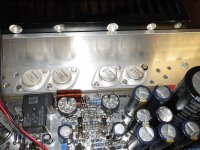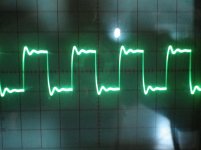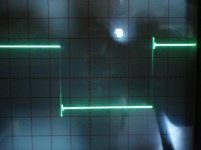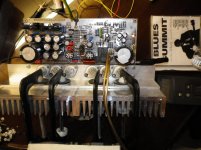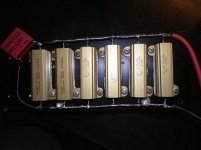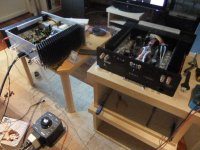Hi
The OP of this thread name it like this , best for him , might not the best for you , it just the title of this thread.
Regards
The OP of this thread name it like this , best for him , might not the best for you , it just the title of this thread.
Regards
Hi,
I would like to assemble this Goldmund clone and wounder (I'm new to amps)
- what the best way to control the volume?
- can I reduce the DC offsett by matching the mosfets (any nice pcb for the matching job known)?
- has the type of mosfet a big influence on the sound or is it the differential-stage of the amp that inproves the sound quality most?
- - if yes which mosfet would you prefer?
Regards
I would like to assemble this Goldmund clone and wounder (I'm new to amps)
- what the best way to control the volume?
- can I reduce the DC offsett by matching the mosfets (any nice pcb for the matching job known)?
- has the type of mosfet a big influence on the sound or is it the differential-stage of the amp that inproves the sound quality most?
- - if yes which mosfet would you prefer?
Regards
Last edited:
It is very hard to subscribe to the term sound quality. It is a subjective way describing what you think you like in terms of what you have experience of.
Amplifiers of different topologies and using different components can sound different and are not necessarily of lower or higher sound quality. The same goes for this sounds better than that, and it depends entirely on your perception of what sounds good, better. or even best.
For instance the chap who started the thread "The Best Amplifier I have Ever Heard" may be the only amplifier he has ever heard. Everybody is qualified to make such a statement.
Amplifiers of different topologies and using different components can sound different and are not necessarily of lower or higher sound quality. The same goes for this sounds better than that, and it depends entirely on your perception of what sounds good, better. or even best.
For instance the chap who started the thread "The Best Amplifier I have Ever Heard" may be the only amplifier he has ever heard. Everybody is qualified to make such a statement.
Okmog
If you're brand new to the soldering iron, I would not recommend Goldmund clone as your first project, unless you have a good friend who has a little more experience and can help you a bit.
Bigpanda plans, from what I understand, a new PCB, where members' experiences are "baked" in. Perhaps it is worth waiting for this to be realized. Then you can avoid some of the problems that some of us after all have experienced.
An absolute prerequisite is that you take the time and the job it is to go through this long thread. There you will find answers to most questions that you ask here in your first letter.
A couple of us have also said something about how we experience the sound quality of Goldmund clone. I (very subjectively) recommended this amplifier. It is also part of the reason that I have built this amplifier twice: Both the Mimesis 9 and 3
Good luck reading this thread. We are many here who you can ask for help and our experience in the building a Golmund clone.
Eivind Stillingen
If you're brand new to the soldering iron, I would not recommend Goldmund clone as your first project, unless you have a good friend who has a little more experience and can help you a bit.
Bigpanda plans, from what I understand, a new PCB, where members' experiences are "baked" in. Perhaps it is worth waiting for this to be realized. Then you can avoid some of the problems that some of us after all have experienced.
An absolute prerequisite is that you take the time and the job it is to go through this long thread. There you will find answers to most questions that you ask here in your first letter.
A couple of us have also said something about how we experience the sound quality of Goldmund clone. I (very subjectively) recommended this amplifier. It is also part of the reason that I have built this amplifier twice: Both the Mimesis 9 and 3
Good luck reading this thread. We are many here who you can ask for help and our experience in the building a Golmund clone.
Eivind Stillingen
ok Sir I'm not brand new in soldering like you said, I studied electronics in the USA army and graduate as a 94F special electronic repair engineer , and is not the first time I fix amplifiers in Puerto Rico, I'm just interested in your project that look really nice, also the software you used for the layout that all my friend.
regards
Juan Vargas
regards
Juan Vargas
Vargasmongo3435
My reply was ment for Okmog, but you are of course also very welcome to the "Golmund clone Club"
Eivind Stillingen
My reply was ment for Okmog, but you are of course also very welcome to the "Golmund clone Club"
Eivind Stillingen
T3-T6
I happen to have a number of Toshiba's 2SC3381 low noise dual npns. Would it be of any advantage if I use them for T3-T6 instead of the BCs in the Mimesis 9?
😕
Life is fun when we mess things up once in a while!
I happen to have a number of Toshiba's 2SC3381 low noise dual npns. Would it be of any advantage if I use them for T3-T6 instead of the BCs in the Mimesis 9?
😕
Life is fun when we mess things up once in a while!
Golmund clone
I bought 8 pieces ECF10P20 and 8 piecesECF10N20 and then I took measurements for Vgs match
ECF10P20
1.258 Volt
1.240
1.282
1.243
1.277
1.243
1.278
1.288
ECF10N20
753 mv
750
743
734
730
767
767
773
I've already placed on P channel 220Ω and 470Ω for N channel under the draft of Ηafler and paper Profusion .
www.profusionplc.com/images/data sheets/ecf10-demo.pdf
I've remained completely in the original design. The only changes I have done is mica 50-100pf/500V capacitor in parallel with two resistors 30k and a small piece aluminum joining Τ7,Τ8,Τ9,Τ10. Offset 1-5mv
I was delighted to counteract the noise and remained in the original design with multiplier . I have no noise and i don't put yet the amp in a box and connect the main earth ground on metal chassis .
I've taken measurements over resistor gate n channel 570 mv and over resistor gate p channel 920mv
Αfter matching of transistor Ι've taken measurements οn resistors source :
N CHANNEL 18mv-18mv-18mv
P CHANNEL 19mv-20mv-19mv
I have put 390Ω for R20
Perhaps this difference between n and p be due because i have not screwed properly the L heatsink with main heatsink.
i put 8Ω load i take square wave measurements
NO different with or without load .
The next days will show photos with measurements.
I bought 8 pieces ECF10P20 and 8 piecesECF10N20 and then I took measurements for Vgs match
ECF10P20
1.258 Volt
1.240
1.282
1.243
1.277
1.243
1.278
1.288
ECF10N20
753 mv
750
743
734
730
767
767
773
I've already placed on P channel 220Ω and 470Ω for N channel under the draft of Ηafler and paper Profusion .
www.profusionplc.com/images/data sheets/ecf10-demo.pdf
I've remained completely in the original design. The only changes I have done is mica 50-100pf/500V capacitor in parallel with two resistors 30k and a small piece aluminum joining Τ7,Τ8,Τ9,Τ10. Offset 1-5mv
I was delighted to counteract the noise and remained in the original design with multiplier . I have no noise and i don't put yet the amp in a box and connect the main earth ground on metal chassis .
I've taken measurements over resistor gate n channel 570 mv and over resistor gate p channel 920mv
Αfter matching of transistor Ι've taken measurements οn resistors source :
N CHANNEL 18mv-18mv-18mv
P CHANNEL 19mv-20mv-19mv
I have put 390Ω for R20
Perhaps this difference between n and p be due because i have not screwed properly the L heatsink with main heatsink.
i put 8Ω load i take square wave measurements
NO different with or without load .
The next days will show photos with measurements.
Attachments
I happen to have 4X 600VA,220V primary-- 0-60V secondary, transformers in stock.
Could I use two of these with the primary connnected in Parallel and the secondary in Series to obtain ±84V DC after the bridge rectifier to be used in this Goldmund Clone?
Could I use two of these with the primary connnected in Parallel and the secondary in Series to obtain ±84V DC after the bridge rectifier to be used in this Goldmund Clone?
Yes.
Each transformer gives a single 60Vac output.
Two transformers will give a 60+60Vac output.
I would be very tempted to treat the output as a dual secondary rather than a centre tapped. This allows one to use separate bridge rectifiers for each transformer secondary.
Then series couple the smoothed outputs from the two PSUs.
Each transformer gives a single 60Vac output.
Two transformers will give a 60+60Vac output.
I would be very tempted to treat the output as a dual secondary rather than a centre tapped. This allows one to use separate bridge rectifiers for each transformer secondary.
Then series couple the smoothed outputs from the two PSUs.
If I was to build a GM clone, I would reduce the output voltage to about 60V dc. This way you could use 63V lytics and , more importantly, use a single pair of 250 watt output devices (BUZ 900D/905D or 20N20/20P20)!
No need for matching the output devices and a probably a more stable and cleaner PCB layout could be made.😀
And maybe I will...😛
No need for matching the output devices and a probably a more stable and cleaner PCB layout could be made.😀
And maybe I will...😛
BMW850, your post is moved to swap meet http://www.diyaudio.com/forums/swap...ds-sale-goldmund-mimesis-9-2-clone-build.html

moderation

moderation
What about using the 2sc3423/2sa1360 as substitute for BSS71/73?
I know Ic max is only 50 mA and the BSS is 500 mA, but as long as only about 25mA is demanded, it should be ok. Cob 1,5 pf. Ft 200 MHz. Hfe 80-240...
1,2W power dissipation without heat sink - 5 W with..
I know Ic max is only 50 mA and the BSS is 500 mA, but as long as only about 25mA is demanded, it should be ok. Cob 1,5 pf. Ft 200 MHz. Hfe 80-240...
1,2W power dissipation without heat sink - 5 W with..
Golmund clone
Rail + / - 70V ---- AC 50V and R32, R33 = 1,8KΩ/4W = result front end voltage about +79,2V /-78V
With fitted resistance R20 at 390Ω the Bias current about 90-100ma for each mosfet
Voltage on source resistor 0,22/5W N Channel 22-22-22 mv and P channel 21-21-22 mv with heatsink 320mm X 100mm X 40 mm , after half an hour the temperature in the heatsink reaches 50 degrees Celsius with room temperature 33 degrees Celsius.
The amplifier is very detailed, particularly at high frequencies and does not go bad in low frequencies with fitted capacitors 10.000mf/100V on rails.
I am no expert technician I have not extensive experience in hearing about amplifier, but I think the amplifier is good enough.
Some results from tests 8Ω load with 2,2mf
1KHZ- 10KHZ - 20KHZ
Rail + / - 70V ---- AC 50V and R32, R33 = 1,8KΩ/4W = result front end voltage about +79,2V /-78V
With fitted resistance R20 at 390Ω the Bias current about 90-100ma for each mosfet
Voltage on source resistor 0,22/5W N Channel 22-22-22 mv and P channel 21-21-22 mv with heatsink 320mm X 100mm X 40 mm , after half an hour the temperature in the heatsink reaches 50 degrees Celsius with room temperature 33 degrees Celsius.
The amplifier is very detailed, particularly at high frequencies and does not go bad in low frequencies with fitted capacitors 10.000mf/100V on rails.
I am no expert technician I have not extensive experience in hearing about amplifier, but I think the amplifier is good enough.
Some results from tests 8Ω load with 2,2mf
1KHZ- 10KHZ - 20KHZ
Attachments
Last edited:
The currently "finishing touches" added to both Goldmund Memesis 9 and 3 is now done: Compensation of the different speed the N channel and P channel FETSs. I use a gate resistor for N channel = 680 ohm and P channel =470 ohm .
What has concerned me in recent times, has been to make Goldmund as stable as possible mulig. It has been useful to go into other threads here on diyAudio and other MOSFET constructions (Hafler), and not at least, the data sheets from Exicon .
Much of this effforts is a result of that Nikos and I have exchanged private e-mails about our building process.
In my Memesis 3 I use 2SK170 BL and MJE 340/50 instead of 2N5565 and BSS71/74. It plays just fine, but I take a break now, eventually they will be replaced with original components to be closer to the original later on.
Now the time has come to enjoy and appreciate the musical result of all the efforts with the construction.
http://dl.dropbox.com/u/12173753/GolmundClone/ecf10-demo.pdf
http://dl.dropbox.com/u/12173753/GolmundClone/XL-280_amp_man.pdf
What has concerned me in recent times, has been to make Goldmund as stable as possible mulig. It has been useful to go into other threads here on diyAudio and other MOSFET constructions (Hafler), and not at least, the data sheets from Exicon .
Much of this effforts is a result of that Nikos and I have exchanged private e-mails about our building process.
In my Memesis 3 I use 2SK170 BL and MJE 340/50 instead of 2N5565 and BSS71/74. It plays just fine, but I take a break now, eventually they will be replaced with original components to be closer to the original later on.
Now the time has come to enjoy and appreciate the musical result of all the efforts with the construction.
http://dl.dropbox.com/u/12173753/GolmundClone/ecf10-demo.pdf
http://dl.dropbox.com/u/12173753/GolmundClone/XL-280_amp_man.pdf
Attachments
Last edited:
- Home
- Amplifiers
- Solid State
- The Very Best Amplifier I Have Ever Heard!!!!
